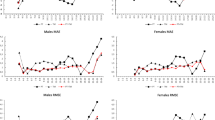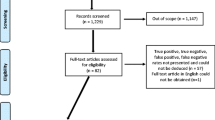Abstract
Dental age estimation methods based on the radiologically detected third molar developmental stages are implemented in forensic age assessments to discriminate between juveniles and adults considering the judgment of young unaccompanied asylum seekers. Accurate and unbiased age estimates combined with appropriate quantified uncertainties are the required properties for accurate forensic reporting. In this study, a subset of 910 individuals uniformly distributed in age between 16 and 22 years was selected from an existing dataset collected by Gunst et al. containing 2,513 panoramic radiographs with known third molar developmental stages of Belgian Caucasian men and women. This subset was randomly split in a training set to develop a classical regression analysis and a Bayesian model for the multivariate distribution of the third molar developmental stages conditional on age and in a test set to assess the performance of both models. The aim of this study was to verify if the Bayesian approach differentiates the age of maturity more precisely and removes the bias, which disadvantages the systematically overestimated young individuals. The Bayesian model offers the discrimination of subjects being older than 18 years more appropriate and produces more meaningful prediction intervals but does not strongly outperform the classical approaches.



Similar content being viewed by others
References
Willems G (2001) A review of the most commonly used dental age estimation techniques. J Forensic Odontostomatol 19:9–17
Kullman L, Johanson G, Akesson L (1992) Root development of the lower third molar and its relation to chronological age. Swed Dent J 16:161–167
Mincer HH, Harris EF, Berryman HE (1993) The A.B.F.O. study of third molar development and its use as an estimator of chronological age. J Forensic Sci 38:379–390 Erratum in: J Forensic Sci 1993;38:1524
Mesotten K, Gunst K, Carbonez A, Willems G (2002) Dental age estimation and third molars: a preliminary study. Forensic Sci Int 129:110–115
Gunst K, Mesotten K, Carbonez A, Willems G (2003) Third molar root development in relation to chronological age: a large sample sized retrospective study. Forensic Sci Int 136:52–57
Solheim T, Vonen A (2006) Dental age estimation, quality assurance and age estimation of asylum seekers in Norway. Forensic Sci Int 159(Suppl 1):S56–S60
Olze A, Reisinger W, Geserick G, Schmeling A (2006) Age estimation of unaccompanied minors. Part II. Dental aspects. Forensic Sci In 159(Suppl 1):S65–S67
Schmeling A, Olze A, Reisinger W, Geserick G (2001) Age estimation of living people undergoing criminal proceedings. Lancet 358:89–90
Gleiser I, Hunt E (1955) The permanent mandibular first molar: its calcification, eruption and decay. Am J Phys Anthropol 13:253–283
Köhler S, Schmelzle R, Loitz C, Püschel K (1994) Development of wisdom teeth as a criterion of age determination. Ann Anat 176:339–345
Demirjian A, Goldstein H (1976) New systems for dental maturity based on seven and four teeth. Ann Hum Biol 3:411–421
Moorrees CF, Fanning EA, Hunt EE (1963) Age variation of formation stages for ten permanent teeth. J Dent Res 42:1490–1502
Thevissen PW, Pittayapat P, Fieuws S, Willems G (2009) Estimating age of majority on third molars developmental stages in young adults from Thailand using a modified scoring technique. J Forensic Sci (in press) doi:10.1111/j1556-4029.2008.00961.x
Chaillet N, Demirjian A (2004a) Dental maturity in South France: a comparison between Demirjian's method and polynomial functions. J Forensic Sci 49:1059–1066
Chaillet N, Nyström M, Kataja M, Demirjian A (2004b) Dental maturity curves in Finnish children: Demirjian's method revisited and polynomial functions for age estimation. J Forensic Sci 49:1324–1331
Chaillet N, Willems G, Demirjian A (2004c) Dental maturity in Belgian children using Demirjian's method and polynomial functions: new standard curves for forensic and clinical use. J Forensic Odontostomatol 22:18–27
Moore D, McCabe G (1993) Introduction to the practice of statistics. W.H. Freeman, New York, p 854
Aykroyd R, Lucy D, Pollard A, Roberts C (1999) Nasty, brutish, but not necessarily short: a reconsideration of the statistical methods used to calculate age at death from adult human skeletal and dental indicators. American antiquity 64:55–70
Aykroyd RG, Lucy D, Pollard AM, Solheim T (1997) Technical note: regression analysis in adult age estimation. Am J Phys Anthropol 104:259–265
Lucy D, Aykroyd RG, Pollard AM (2002) Non-parametric calibration for age estimation. Appl Stat 52:185–196
Prince DA, Konigsberg LW (2008) New formulae for estimating age-at-death in the Balkans utilizing Lamendin's dental technique and Bayesian analysis. J Forensic Sci 53:578–587
Prince DA, Kimmerle EH, Konigsberg LW (2008) A Bayesian approach to estimate skeletal age-at-death utilizing dental wear. J Forensic Sci 53:588–593
Hedeker D, Gibbons RD (1994) A random-effects ordinal regression model for multilevel analysis. Biometrics 50:933–944
Schmeling A, Grundmann C, Fuhrmann A, et al. (2008) Criteria for age estimation in living individuals. Int J Legal Med (in press)
Schulz R, Mühler M, Reisinger W, Schmidt S, Schmeling A (2008) Radiographic staging of ossification of the medial clavicular epiphysis. Int J Legal Med 122:55–58
Schulz R, Mühler M, Mutze S, Schmidt S, Reisinger W, Schmeling A (2005) Studies on the time frame for ossification of the medial epiphysis of the clavicle as revealed by CT scans. Int J Legal Med 119:142–145
Schmeling A, Schulz R, Reisinger W, Mühler M, Wernecke KD, Geserick G (2004) Studies on the time frame for ossification of the medial clavicular epiphyseal cartilage in conventional radiography. Int J Legal Med 118:5–8
Greulich WW, Pyle SI (1959) Radiographic atlas of skeletal development of the hand wrist. Stanford University Press, Stanford
The 2007 Recommendations of the International Commission on Radiological Protection (2007) ICRP publication 103. Ann ICRP 37:1–332
Dhanjal KS, Bhardwaj MK, Liversidge HM (2006) Reproducibility of radiographic stage assessment of third molars. Forensic Sci Int 159(Suppl 1):S74–S77
Kim YK, Kho HS, Lee KH (2000) Age estimation by occlusal tooth wear. J Forensic Sci 45:303–309
Gustafson G, Koch G (1974) Age estimation up to 16 years of age based on dental development. Odontol Revy 25(297):306
Solheim T (1992) Recession of periodontal ligament as an indicator of age. J Forensic Odontostomatol 10:32–42
Bar-Hillel M (1980) The base-rate fallacy in probability judgements. Acta Psychol 44:211–233
Thompson W, Schumann E (1987) Interpretation of statistical evidence in criminal trials: the prosecutor's fallacy and the defense attorney's fallacy. Law Human Behavior 11:167–187
Harrell FE (2001) Regression modeling strategies. Springer, New York
Molenberghs G, Verbeke G (2005) Models for discrete longitudinal data. Springer, New York
Author information
Authors and Affiliations
Corresponding author
Appendix: Bayesian approach
Appendix: Bayesian approach
A multivariate ordinal regression model to obtain the likelihoods \( f\left( {x_{i1}, ...,x_{i4} {\text{|age}}_i } \right) \):Formally, let x ij denote the j-th third molar stage, j = 1,…,4, for subject i, with K possible values, then
where α 0k α 0k are the K − 1 intercept terms to model the marginal frequencies in the K ordered categories of the stage. The left-hand side of the equation represents various logits, i.e., natural logarithms of a specific odds (the odds of observing a stage lower than a specific value k). Observe that if a developmental stage would only have two different values (say 1 and 2), the left-hand side would pertain to a single logit, yielding a binary regression model. A binary indicator U is valued 1 if the third molar is located in the upper jaw and 0 elsewhere. The α 1k quantify the difference in stage between upper and lower jaw. The subscript k indicates in the latter that the effect of jaw is allowed to be non-constant over the intercepts implicating that a proportional odds assumption is not made for this effect. A flexible function h(.) is used to relate age to the logit scale, more specifically, restricted cubic splines have been used [36]. The key idea is to allow non-linearity (on the logit scale) in a flexible way without over fitting the data. Finally, the b i denotes the random subject effect, assumed to be normal distributed. By including this term in Eq. 3, each subject i is allowed to have its own stage level (on logit scale), hereby accounting for the correlation, which exists between the four repeated stage measures. The resulting model is a generalized linear mixed model, where the term mixed refers to the simultaneous presence of fixed effects (i.e., age and jaw) and a random effect (the b i ). See for example Molenberghs and Verbeke [37]. Due to the low incidence of stages lower than or equal to 5, those stages are combined into one category. Moreover, no distinction is made between the location (left/right) of a stage. As such, a stage pattern “8 8 6 7” pertains to two stages equal to 8 in the upper jaw and one stage 6 (left or right) and one stage 7 (left or right) in the lower jaw. The generalized linear mixed model is fitted with the procedure PROC NLMIXED in the SAS 9.1 statistical package (SAS Institute, Cary, NC, USA), using adaptive Gaussian quadrature.
Once model Eq. 3 is fitted on the data, the likelihood \( f\left( {x_{i1}, ...,x_{i4} {\text{|age}}_i } \right) \) \( f\left( {x_{i1}, ...,x_{i4} {\text{|age}}_i } \right) \) can be calculated for all possible patterns (x i1,…,x i4) given a specific age. This has been done in steps of 0.1 years, hence the integral in the denominator of Eq. 2 is replaced by a sum over age intervals of 0.1 years and the posterior distribution in Eq. 2 will also have steps of 0.1 years as support points. For the prior distribution, a uniform distribution has been used, implying that each age-category within the considered range (16–22 years for the comparison of the approaches) is given the same (prior) probability.
Rights and permissions
About this article
Cite this article
Thevissen, P.W., Fieuws, S. & Willems, G. Human dental age estimation using third molar developmental stages: does a Bayesian approach outperform regression models to discriminate between juveniles and adults?. Int J Legal Med 124, 35–42 (2010). https://doi.org/10.1007/s00414-009-0329-8
Received:
Accepted:
Published:
Issue Date:
DOI: https://doi.org/10.1007/s00414-009-0329-8




